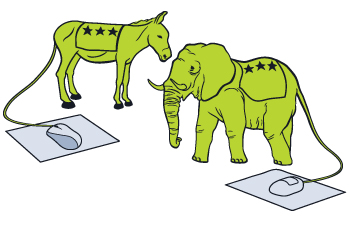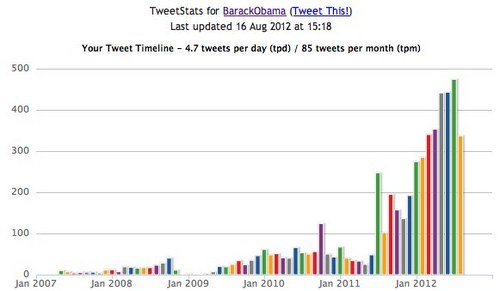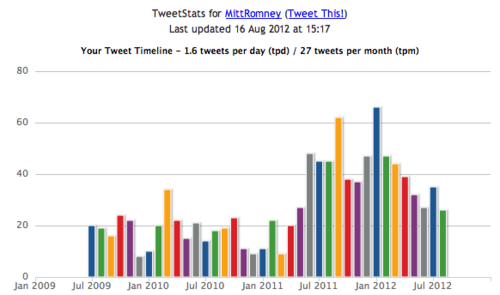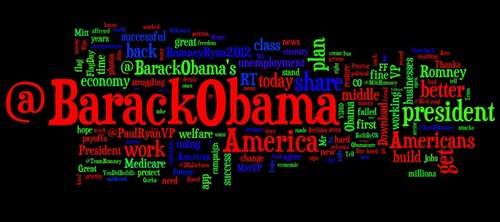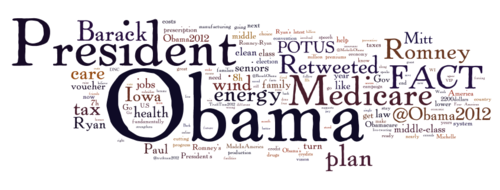If an election outcome rested on how well a campaign does with Twitter, then President Barack Obama’s camp would be focused not on November 2012 but January 2013. Not only is the Obama campaign out-tweeting the Mitt Romney team, but the Obama tweets are being shared at a rate of 17-to-1 compared with Romney’s.
The Pew Project for Excellence in Journalism analyzed the digital activity of the two campaigns over a two-week period in June. The report shows that there is a “digital gap“ between the presumed Republican and Democratic candidates for president, just as there was between Obama and John McCain in 2008.

The report reviews candidate activity across a mature set of digital platforms: Facebook, Twitter and YouTube plus the campaign websites. In June, the Obama campaign had a presence on nine social media platforms: Facebook, Flickr, Google+, Instagram, Pinterest, Spotify, Twitter (@BarackObama plus five others), Tumblr and YouTube. The Romney campaign had public accounts on only five: Facebook, Flickr, Google+, Twitter and YouTube; it has subsequently added Tumblr and Spotify, according to the report.
A digital legacy
Obama established a broad digital presence in 2008 and has maintained it throughout his presidency. Thus it is not surprising that his digital support dwarfs Romney’s.
For example, on Facebook, today the Obama’s campaign page has almost 28 million likes versus 4.5 million for Romney’s campaign. On Twitter, <a href="https://twitter.com/BarackObama">BarackObama</a> has 18.6 million followers; MittRomney has 863,000. On YouTube, Obama has 210,000 subscribers (214 million views) whereas Romney has almost 15,000 subscribers (18 million views).
The Obama campaign is not only active in more spaces, it’s more active, period. Across the platforms analyzed in this report, the Obama campaign posted almost four times as much content as the Romney campaign: There were 614 Obama posts in the two-week period but only 168 posts by Romney.
A Twitter gap
This gap was most evident on Twitter, where <a href="http://twitter.com/BarackObama">BarackObama</a> averaged 17 tweets per day and MittRomney averaged one tweet per day. On Facebook, the campaigns are neck-and-neck. The Obama campaign produces more videos for YouTube and more content for the website blog than the Romney campaign.
Analysis of both accounts using Seattle-based Tweetstats makes the point about the Twitter gap visually.
Content
But what do the campaigns talk about in these spaces? And to whom?

Both campaigns were focused on the economy in June, with 1-in-4 Romney postings and 1-in-5 Obama postings discussing the subject.
What differed was the approach.
Romney’s campaign made twice as many posts focused on jobs as Obama. Reflecting the cerebral candidate that he is, Obama’s campaign spent just as much time talking about “broader economic policy issues such as the need to invest in the middle class and how the election presents a choice between two economic visions.”
Here are two tweets that illustrate the difference.
Barack Obama, August 14: “I don’t believe in an economy from the top down. I believe that the economy grows from the middle class out, and from the bottom up.”
Mitt Romney, August 12: “If your priority is creating more jobs and putting more people to work, that’s what we know how to do. #RomneyRyan2012“
Not surprisingly, the challenger was more than twice as likely to mention the incumbent than the other way around. In June, Romney’s campaign devoted about a third of its posts to Obama, “largely attacking him for a policy stance or action.” The Obama campaign mentioned Romney half as much.
Wordle, a tool used to visualize how frequently words appear in a text, starkly shows this difference.
Also, the Romney campaign is much more likely to communicate with an image or a video than the Obama campaign, making an emotional appeal versus a rational appeal.
But in the public spaces — YouTube, Twitter and Facebook — neither campaign goes out of its way to actually talk with citizens.
The report notes that is rare for either candidate to “reply to, comment on or retweet something from a citizen.” Although if it is going to happen, the odds are that it will be the Obama campaign.
In its analysis of June tweets, the report shows that only 16% of @BarackObama tweets were retweets. Most of those were campaign related; only 3% of all tweets were “retweets of citizen posts.” During the two-week analysis, the Romney camp had one retweet.
TweetStats reveals that the June pattern is the norm for both campaigns. Over the lifetime of the two Twitter accounts, BarackObama shows 14% retweets and MittRomney shows 2%.


The campaigns may not interact with voters, but they regularly issue calls for action, with “about half of each candidate’s posts [including] a request for some kind of voter follow-up activity.”
“These calls to action were most common on the website blog posts. Every single blog post from the Obama campaign during the time studied included some call to action, as did 91% of his YouTube posts. Most, 81%, of Romney’s homepage content and 40% of his YouTube video posts had calls to action as well. Twitter was the platform least likely to contain a call to action,” according to the Pew report.
“For Obama, the primary call to action most often (51% of the time) was a request for some kind of digital-oriented response, such as watch this video, join this list or sign up to be part of a ‘team,’” the report said. “For Romney the request that appeared first most often (31% of the time), was to donate money. These tended to appear in the form of a donate button.”
Some of those calls for action include “share this post.”
The most popular platform for engagement turns out to be Facebook, not Twitter.
Likes and dislikes
The Pew researchers recorded the likes and dislikes (where appropriate), comments, retweets and views for up to 48 hours after posting. The Obama campaign posts on Facebook generated more than 1,100,000 likes. The Romney campaign generated about 635,000 likes, about half as many.
But the Obama campaign posts more often than the Romney campaign, so average likes per post is an important metric. Obama Facebook posts had an average of 2,938 comments per post versus an average of 1,941 for Romney’s.
The Obama campaign had more than 150,000 retweets during this two-week period. Romney, on the other hand, had almost 8,600 retweets. However, on Twitter the ratio between the two campaigns matches: 17-to-1 total tweets, 17-to-1 retweets.
And the Obama campaign YouTube videos averaged 466 likes per video compared with 253 per video for the Romney campaign.

In comparing the 2008 and 2012 campaigns, the Pew researchers ignore Twitter, saying that it “was not in the mix in 2008.” That is not the case.
John Edwards was the first presidential candidate to embrace Twitter. Barack Obama sent his first tweet in 2007:
“Thinking we’re only one signature away from ending the war in Iraq. Learn more at http://www.barackobama.com 12:04 PM Apr 29th, 2007 from web”
On August 10, 2008, the Obama campaign used Twitter to invite supporters to be among the first to know the pick for vice president. Announcements were made by text and email.
By the end of the campaign, Obama’s presence in the emerging network was phenomenal, and 165,000 people had signed up for one-way political advertisements.
It may be hard to believe, but in 2008 YouTube was also a new platform for political communication. YouTube gives candidates the opportunity to share longer messages than financially possible on television. And like Facebook and Twitter, it encourages sharing.
All campaigns want their videos to “go viral,” to be shared quickly and widely.
In the two-week period, the researchers report than no video went viral. Videos for both campaigns averaged about 40,000 views within 48 hours of posting. But the most popular video wasn’t campaign-related but human-related: it was Michelle, Malia and Sasha Obama’s Father’s Day card. Its metrics: 2,265 Facebook shares in the first 48 hours and 211,663 YouTube views.
The History and the Future
Political digital campaigning truly got its start with the Howard Dean campaign in 2004. Ron Paul’s supporters demonstrated the potential of the medium for fundraising when they contributed more than $4.2 million on November 5, 2007; Paul was polling in the single digits at the time.
But just as Harry Truman was the first president to make a coast-to-coast address on television in 1951, it wasn’t until the Kennedy-Nixon debates in 1960 that the medium had an impact on political communication. Those who heard the debate on the radio thought Nixon had won; those who watched on television picked Kennedy. Kennedy went on to win the contest, and “more than half of all voters reported that the Great Debates had influenced their opinion; 6% reported that their vote was the result of the debates alone.”
We’ll not know for a while whether a similar watershed moment for digital political communication came during the Dean, Paul or Obama (first) run for president. But there is no doubt that a generation immersed in digital communication technologies will turn to these tools to learn about candidates and issues. And not just turn to them first; eventually, they’ll turn to them only.
Update: 9:30 pm Pacific, Friday 17 August
@EricEarling alerted me to a critical analysis of the Pew study at BuzzFeed Politics. Vincent Harris argues that Pew looked at the wrong Facebook metrics. He points out that the Romney Facebook page shows more people (1,847,350) “talking about this” than the Obama Facebook page (1,441,696).
Facebook defines the “talking about this” metric (pdf) thusly: “The number of unique people who have created a story about your Page in the last seven days.” Because Facebook’s version of “create a story” might not match yours, here is their list:
This metric includes everyone who, in the past week, has:
- Liked your Page
- Liked, commented on, or shared your Page post
- Answered a Question you’ve asked
- Responded to your event
- Mentioned your Page
- Tagged your Page in a photo
- Checked in or recommended your Place
The Pew study looked at a subset of the “talking about this” dataset.
If a person does all of these things over the course of seven days, she is reportedly counted only once; these are supposed to be unique impressions.
Harris writes:
This means that more people are actually interacting with content on Mitt Romney’s page than Barack Obama’s page despite Obama’s having an almost 7 to 1 advantage in total fans over Romney.
Because this metric includes new “likes”, I would argue that it might show that Obama has a more stable base of “fans” (Facebook doesn’t call them that anymore but I don’t have a better word at the moment). If the metric did not include new “likes”, then I would agree that it might be a good public measure of current engagement with content.
When the metric rolled out, Beth Kanter asked if the metric was valid or shallow and got a very mixed response from the nonprofit world.
These technologies are new and changing. How we (voters) interact with them is evolving. How we (content owners) make assessments about that engagement/interaction is also evolving.
The most important thing we can do, I think, is to try to move beyond popularity contest numbers (number of likes, number of followers) — something Pew tried to do.
Finally, remember that the key metrics — the ones that help any page owner figure out if she is helping her fans/visitors make the world a better place — are visible only to page administrators.
Kathy Gill has been online since the early 1990s, having discovered CompuServe before Marc Andreessen launched Mosaic at the University of Illinois in 1993. In 1995, she built and ran one of the first political candidate websites in Washington state. Gill then rode the dot-com boom as a communication consultant who could speak web, until the crash. In 2001, she began her fourth career as an academic, first teaching techies about communications and now teaching communicators about technology. At the University of Washington, she teaches undergraduates as well as classes in the Master of Communication in Digital Media program. For almost five years, she covered politics for About.com; for three years, she covered agriculture.
